9 February 2004
Somewhere in Peru
Four days in a Dodge
Each travel holiday is filled with interesting stories and vignettes and in this case we prefer not to tell them in chronological order.
Puno 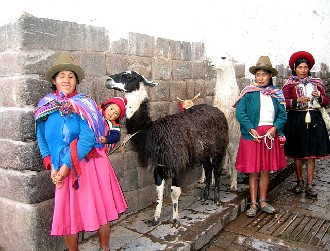
Lying flat on my back, I open one eye and am able to make out the TV hung high on the wall at the end of the bed. The Flintstones movie, which is dubbed in Spanish, is playing and the screen so fuzzy that it is difficult to tell Fred from Barney. Even Steven Spielberg couldn't recognize his movie with such poor reception. But hey how much of a plot can there be? It is cold in the room and the $3.00 per day electric heater has so far been unable to warm the room enough so that I can comfortably take off my jacket. There are four or so layers of blankets on the bed for those choosing not to pay for the heater but at this altitude it is already difficult to breath and ten pounds of blankets on your chest can be very uncomfortable.
My stomach is rolling and rolling and my lower GI tract is twisted and untrustworthy. For four days now I have suffered from acute diarrhea. Rene now occupies the throne and I am hopeful that she won't take much longer. She is also suffering but does so without complaining and in a much quieter manner. After two days of Imodium, I have switched to the antibiotic Metronidazole without immediate success. We cannot travel anywhere without toilet tissue since it is never available and to compound the problem the toilet seats disappear when the bowls are installed. The hotel has switched on the hot water and in an hour or so we should have some in our room but in the mean time........eh oh........... got to go ............. Wilma.......... Wilma.
Earlier today we took a boat tour of Lake Titicaca, one of the highest navigable bodies of water in the world and home of the floating reed villages. 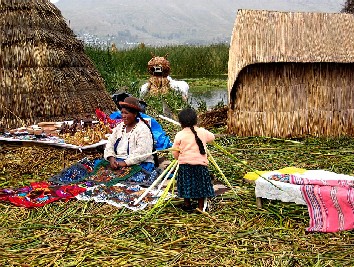 The lake divides Peru and Bolivia and our Peruvian guide told us the "kaka" part was located in Bolivia. This region, as legend has it, is where the Inca originated before moving to Cuzco to establish their empire. After only a few days we realize how little is known about the Incas prior to the encounter with the Spanish. And of course even less is know outside of Peru about the pre-Inca civilizations such as the Wari, the Chanka and others. These civilizations were conquered by the Inca and in most cases were incorporated into the empire that at one time stretched throughout Ecuador, Bolivia and Peru and took in part of Chile. Without a written language there was no recorded history of the western hemispheres largest early civilization. Today many earlier assumptions about the Inca are being discarded for a more honest answer. which is "We don't know. " The lake divides Peru and Bolivia and our Peruvian guide told us the "kaka" part was located in Bolivia. This region, as legend has it, is where the Inca originated before moving to Cuzco to establish their empire. After only a few days we realize how little is known about the Incas prior to the encounter with the Spanish. And of course even less is know outside of Peru about the pre-Inca civilizations such as the Wari, the Chanka and others. These civilizations were conquered by the Inca and in most cases were incorporated into the empire that at one time stretched throughout Ecuador, Bolivia and Peru and took in part of Chile. Without a written language there was no recorded history of the western hemispheres largest early civilization. Today many earlier assumptions about the Inca are being discarded for a more honest answer. which is "We don't know. "
Hello my name is Michael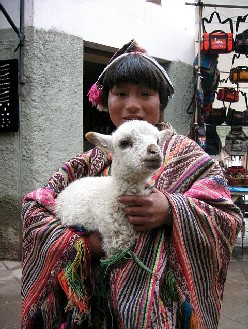
Noticeable in the high tourists areas of Peru and especially in Cuzco, are the street vendors of artisan craftwork, tour operators, restaurant touts and photo op characters standing around in authentic costumes with a prop llama or alpaca tethered under their arms. Mixed among them are the smaller street urchins selling shoe shines, postcards or individual pieces of candy. These poorer and younger vendors are in need of a much more polished approach. They are for the most part equipped with English skills and introduce themselves and establish a rapport without mentioning the product or service they have to offer. They ask open-ended questions and are in no hurry to close the sale. After a breezy minute or two they ask if you would like to buy some postcards. With a dash of humor and top notch negotiating skills they come away with a sale from the recent arrivals. They never take no for an answer no matter how persistent you may be. "Okay, then later maybe but remember my name is Michael." "O.K. Michael, maybe later." "Promise?". "No Michael, I don't promise." After you buy a post card or two and they focus their efforts on the newer arrivals. Where the sales training comes from I don't know but I know in the US you would pay big bucks to have such a talented sales force.
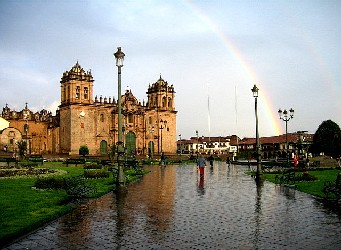
Cuzco is a city of about 300,000 residents which is about the same population as when it was inhabited by the Inca. The city was the center of the earth for the Inca and it was from here that the empire started its expansion efforts. We are staying a block or two off the Plaza de Armas and have taken the prerequisite City Tour and Sacred Valley Tour. We have acclimated ourselves at this altitude for three days now but still we wake up in the middle of the night wondering why until we realize we are short of breath and just need to suck in a little more O2. We are drinking our allotment of coca tea, have tried the alpaca steaks and have a bag full of coca leaves to chew on along the Inca trail, we are now ready for Machu Picchu. Still the last hill up to our hotel always leaves us panting and holding onto the wall of the entryway for several minutes before entering the lobby.
Four days in a Dodge
Not able to find a suitable schedule by bus, plane or train 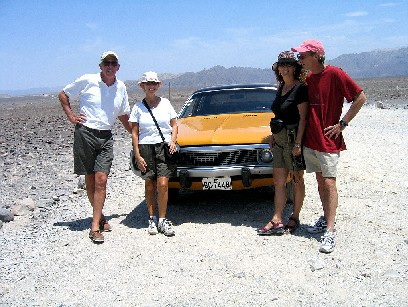 and finding rental car drop off charges to be prohibitive, we hired a private car to take us from Arequipa to Lima. Mark and Jane are our traveling companions and Mark has a good command of Spanish and a penchant for deal making. By way of a taxi driver we met on the street, Mark was able to connect with a guide who owned his own car, a 1963 Dodge Cornet. The motor had been switched out to a Toyota Turbo charged diesel, the paint and upholstery were new and boy was it roomy. The driver/guide, Javier Llamas Vega, fluent in Spanish and Italian, had good recommendations as to where to stay and eat and we had the flexibility of stopping whenever we wanted and to change our schedule at will. and finding rental car drop off charges to be prohibitive, we hired a private car to take us from Arequipa to Lima. Mark and Jane are our traveling companions and Mark has a good command of Spanish and a penchant for deal making. By way of a taxi driver we met on the street, Mark was able to connect with a guide who owned his own car, a 1963 Dodge Cornet. The motor had been switched out to a Toyota Turbo charged diesel, the paint and upholstery were new and boy was it roomy. The driver/guide, Javier Llamas Vega, fluent in Spanish and Italian, had good recommendations as to where to stay and eat and we had the flexibility of stopping whenever we wanted and to change our schedule at will.
On bus tours the stretch from Arequipa to Lima is made at night since there is nothing to see and yet it is the great amount of nothing that makes the area so interesting. Vast expanses of arid land, sand dunes and desert go for miles on end and then suddenly the the light brown color is interrupted by a green river valley where fields of grapes, rice, and cotton are grown. These thin strips of green quickly disappear and again you are surrounded by ocean beaches that stretched for twenty miles back toward the mountains. The sand blows so hard that the 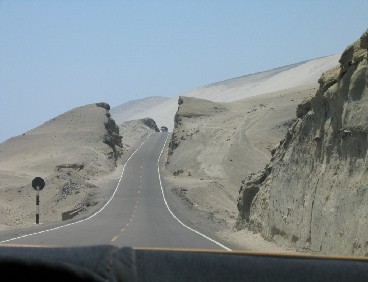 Pan American highway disappeared in the horizon. For the better part of three days, we drove in this great north/south wasteland never tiring of the lunar like topography. Pan American highway disappeared in the horizon. For the better part of three days, we drove in this great north/south wasteland never tiring of the lunar like topography.
Just outside of Nazca, Javier led us to a motel complex where we ended up being the only guest and the only customers at the restaurant that evening. It is a popular resort during the season but we were off season and one swimming pool was empty and the other was a bit too dirty to try out. The next morning we took a private plane to view the Nazca lines. These figures in the desert are built to be most visible from altitude so it is curious as to what purpose they served other than to attract future generations of sightseers. The lines are scratched out of the desert by removing the darker colored stone from the surface and exposing the lighter colored mineral below and have lasted some 2000 years since there is little or no rain. The pilot knew just enough English to point out the Monkey, the Trapezoid, the Hands, the Astronaut, the Hummingbird, the Condor, the Whale, etc, etc.
Lima
We had two days before departure and were interested in seeing a bit of night life Lima style. We left the Mira Flores district by taxi and entered the El Portal de Barranco, a small square surrounded by bars, restaurants and night clubs. We chose the Cuban music review with a twelve piece band, La Vieia Trova, dance leader included. They referred to themselves as the Los Abuelos de la Bohemia or the grandfathers of Bohemia. Since only one appeared to be under 70 it was apparent that this music they played was from before the Castro period which began in 1959. But even today they were able to fill the house despite the rather stiff cover and the dance leader could get the crowd up and onto the dance floor.
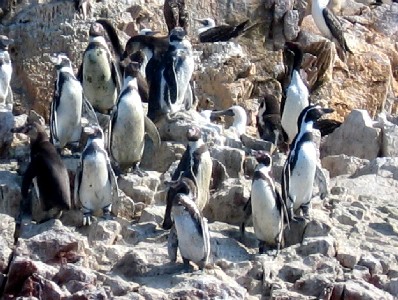
Humboldt Current
We stopped in Paracas to take a short boat ride to Isla Ballestas and visit this small island noted for its guano production. For three months of every year, 200 men are allowed on the island to scoop the nitrogen rich bird poop and ship it to Japan or Western Europe where it commands a price of around $10 per kilo.
The Ballestas islands are also noted for the sea lions, Humboldt penguins, cormorants, the Peruvian booby, pelicans and several other species of birds that colonize these small islands. By this time in the trip my own case of guano production is starting to subside and I am not intimidated by the two hour boat ride (inquiring minds want to know).
Machu Picchu
There are several ways to see Machu Picchu. One is to take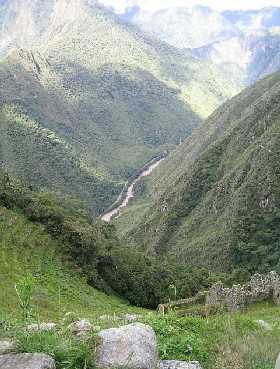 a four day hike up the Inca trail or should I say an Inca trail since there are more than 22,000 miles of trails once used by the Incas. The second is to take the two day hike and the third is to take the bus. We decided on the two day hike and after half a day we were glad to have foregone the four day event. The five or so groups of eight hikers stretched out along the trail, leaving the river 1000 meters below. Our guide had an excellent knowledge of local flora and fauna and pointed out the great variety of orchids along the way. Three hours into the event and we were dripping in sweat and only occasionally refreshed by the cool breezes on the ridge lines. Around four-thirty in the afternoon, we arrived at the hostel where we would spend the night and where we could buy cold beer. You can really appreciate a cold beer when you know that every bottle had to be hand carried up the trail along with dinner, breakfast and at sometime or another that toilet sans seat. But hey we were living large, celebrating our accomplishment and consuming several beers at altitude. Tomorrow we would rise at 4:00 AM and be at the sun gate entrance of Machu Picchu by 6:45. The hostel stacked 45 or so in the room in bunk beds two, three and four high with one toilet (no seat) and of course no paper. a four day hike up the Inca trail or should I say an Inca trail since there are more than 22,000 miles of trails once used by the Incas. The second is to take the two day hike and the third is to take the bus. We decided on the two day hike and after half a day we were glad to have foregone the four day event. The five or so groups of eight hikers stretched out along the trail, leaving the river 1000 meters below. Our guide had an excellent knowledge of local flora and fauna and pointed out the great variety of orchids along the way. Three hours into the event and we were dripping in sweat and only occasionally refreshed by the cool breezes on the ridge lines. Around four-thirty in the afternoon, we arrived at the hostel where we would spend the night and where we could buy cold beer. You can really appreciate a cold beer when you know that every bottle had to be hand carried up the trail along with dinner, breakfast and at sometime or another that toilet sans seat. But hey we were living large, celebrating our accomplishment and consuming several beers at altitude. Tomorrow we would rise at 4:00 AM and be at the sun gate entrance of Machu Picchu by 6:45. The hostel stacked 45 or so in the room in bunk beds two, three and four high with one toilet (no seat) and of course no paper.
We started the next morning in a light drizzle with flashlights in hand to illuminate the wet two foot wide path. At the Sun Gate entrance of Machu Picchu, the fog and low hanging clouds shrouded the city refusing to appear to the hardy few hanging on the side of the terraced fields. After waiting a while and with coaxing from our guide, it was down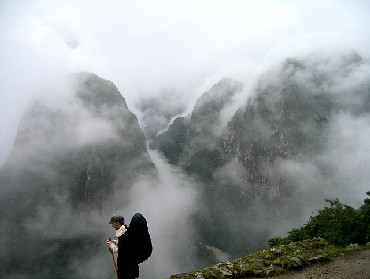 to the second observation point and from here the site revealed itself if for only a minute before drawing a curtain of clouds obscuring our view. For all of us who had envisioned a postcard picture it was not to be but it was still a magical view. The guide told us that 90% of the time the sun does not come through the Sun Gate and that the reason for the early departure was to be in the city several hours before the bus tourists arrived. to the second observation point and from here the site revealed itself if for only a minute before drawing a curtain of clouds obscuring our view. For all of us who had envisioned a postcard picture it was not to be but it was still a magical view. The guide told us that 90% of the time the sun does not come through the Sun Gate and that the reason for the early departure was to be in the city several hours before the bus tourists arrived.
Machu Picchu is mysterious in many ways. No one knows why the city was built or if it served a special purpose. It was rediscovered in 1911 and that is why it is sometimes referred to as " the lost city of the Incas". As you look out upon the stone work of this city it is hard to fathom how it could be built in this inaccessible terrain. Then you realize that the stone work that remains represents only 20% of the preparation work necessary to level the mountain top, reshape the agricultural fields and lay the earthquake proof foundations that are underground. There are 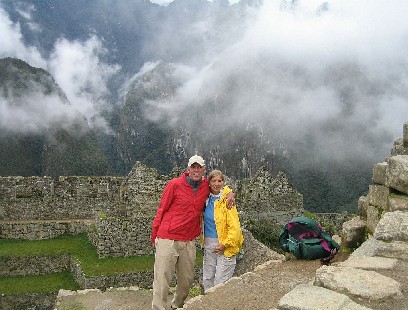 several conclusions that can be drawn from the stone work. The more intricate and larger stones are an indication that the building contained a high ranking Inca or that the building was used as a shrine of some sort. These stones are split and then hand polished to fit exactly with the surrounding stones without mortar. The complexity of the angles and the fit of each stone lead some to believe that the Inca alone could not have completed all of these works in the short 100 year history of the empire but rather that the pre-Inca must have provided the ground work for many of the sites. There are some who have confidence that the Inca did indeed accomplish all this and would have accomplished much more if there had not been such internal strife in the Empire. And finally there are those that believe that only aliens from the outer limits could have given the poor Inca and their forbearers the technology or tools to accomplish such feats of construction and engineering. Well what ever you care to believe there is little proof and therefore the fascination with this place will continue ad infinitum. several conclusions that can be drawn from the stone work. The more intricate and larger stones are an indication that the building contained a high ranking Inca or that the building was used as a shrine of some sort. These stones are split and then hand polished to fit exactly with the surrounding stones without mortar. The complexity of the angles and the fit of each stone lead some to believe that the Inca alone could not have completed all of these works in the short 100 year history of the empire but rather that the pre-Inca must have provided the ground work for many of the sites. There are some who have confidence that the Inca did indeed accomplish all this and would have accomplished much more if there had not been such internal strife in the Empire. And finally there are those that believe that only aliens from the outer limits could have given the poor Inca and their forbearers the technology or tools to accomplish such feats of construction and engineering. Well what ever you care to believe there is little proof and therefore the fascination with this place will continue ad infinitum.
The windows fabricated of stone indicate a place of special use and the window like structures in a closed wall may have been used to project the human voice, as a place to display idols of pachamama (mother earth), pachapapa or others but everyone agrees that they provided protection from the movement of the earth in this earthquake prone area of the world. In fact we were able to experience a little tremor ourselves.
Much is made of the sundials and observatories used by the Incas to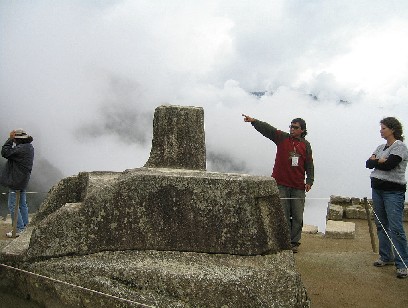 determine when the winter and summer solstice but it is uncertain if there was any other significances to these astronomical structures. What or who the Incas worshiped is only partially known. It is known that they asks for blessing from the mountains and from the coca leaves and coca played a very important part in the everyday lives of the Incas. determine when the winter and summer solstice but it is uncertain if there was any other significances to these astronomical structures. What or who the Incas worshiped is only partially known. It is known that they asks for blessing from the mountains and from the coca leaves and coca played a very important part in the everyday lives of the Incas.
Coca tea is served everywhere at elevation and coca leaves are sold on the street. To assist in the climb you take about three leaves and one by one put them in your mouth and in so doing pull out the stem. From that point on its about like snuff. No great high but maybe a little pick me up for the road.
Peru
Indigenous people of the Andes are short with light brown skin, black hair and have dark eyes. They are also endowed with a very large lung capacity and a sizable heart, all features 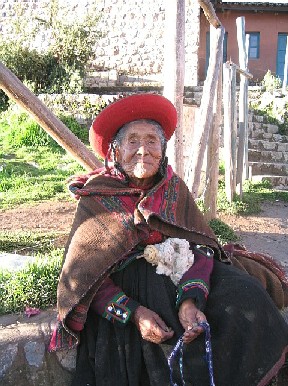 to accommodate living in such high altitudes. Doorways are low and shower heads even lower. You sometimes get the feeling that you're towering over people when you are walking in the Plaza. We are easy to spot with our red and yellow rain jackets while everyone else is in a dark alpaca sweaters. In Lima the look is more European and certainly more modern. to accommodate living in such high altitudes. Doorways are low and shower heads even lower. You sometimes get the feeling that you're towering over people when you are walking in the Plaza. We are easy to spot with our red and yellow rain jackets while everyone else is in a dark alpaca sweaters. In Lima the look is more European and certainly more modern.
The colonial period started with the Spanish Conquistador Francisco Pizarro who entered the Inca domain in 1582 with about 180 men. The exploits of Parraizo are well documented since several expedition members kept chronicles of their plunder. Within a few days the Spaniards had captured the Inca King Atahuallpa, killed thousands and lay claim to the entire empire. Atahuallpa offered to ransom his freedom with a room full of gold and two rooms full of silver. But in the end the Spaniards fearing the Inca army, took the treasure and tried Atahuallpa sentencing him to be burned at the stake. In order to avoid such a horrible death the Inca King renounced his God and agreed to be baptized. For this admonition of his faith he was given a lighter sentence, that of being garroted, a typical Spanish death sentence for criminals. Francisco Parraizo was never mentioned during our visit to Peru.
In proselytizing Catholicism the Spanish destroyed many of the Inca locations which may have been used as holy places or temples and then in a more practical endeavor pirated the stones from the Inca monuments to build Cathedrals, governments buildings and colonial houses. 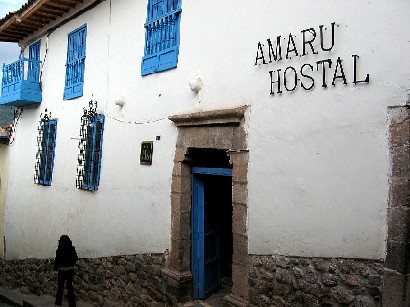 Certain laws were passed to make cities like Cuzco appear more European. Built upon the foundations of Inca cities buildings soon incorporated windows and balconies that were required to be blue as they were in Spain. Even today the requirement remains no doubt to entertain the tourists. Certain laws were passed to make cities like Cuzco appear more European. Built upon the foundations of Inca cities buildings soon incorporated windows and balconies that were required to be blue as they were in Spain. Even today the requirement remains no doubt to entertain the tourists.
Building techniques today are mostly adobe. At suitable sites the hills are excavated to remove the rich loam which is then formed into a brick about the size of a cinder block. These brown adobe blocks are then used to form a house or building some several stories tall. They are then roofed with with tin or red tile. The use of red tile has ravaged the local woodlands since the trees were used to make charcoal which was used to fire the tiles. The brown colored bricks typically go unpainted and therefore the color matches the hillside which sits behind the building scarred and barren. All in all it provides a drab series of buildings and surrounding in the outskirts of Cuzco.
Peruvian governments continued to change mostly through military overthrow, revolution or revolt and even the occasional election. The currency of Peru, the sol, is pegged to the dollar and even ATM machines give you the option of US dollars or sols. 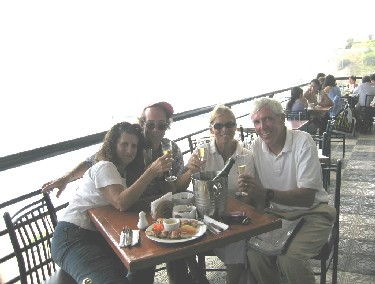 In the US we use dead Presidents to adorn our currency but given the violent overthrow of governments in South America this is not appropriate because it would cost too much to reprint all the currency every time there was a change of government. In the US we use dead Presidents to adorn our currency but given the violent overthrow of governments in South America this is not appropriate because it would cost too much to reprint all the currency every time there was a change of government.
It was a great made even more enjoyable by our traveling companions Mark and Jane from the SV Pegasus.
If you want to view more pictures of our Peruvian adventure, just click on the slideshow below
Back Next
|